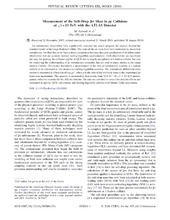Measurement of the soft-drop jet mass in pp collisions at √s=13 TeV with the ATLAS detector
Aaboud, Morad; Aad, Georges; Abbott, Brad; Abdinov, Ovsat Bahram oglu; Abeloos, Baptiste; Abidi, Syed Haider; AbouZeid, Hass; Abraham, Nadine L.; Abramowicz, Halina; Abreu, Henso; Buanes, Trygve; Dale, Ørjan; Eigen, Gerald; Liebig, Wolfgang; Lipniacka, Anna; Martin dit Latour, Bertrand; Mæland, Steffen; Stugu, Bjarne; Yang, Zongchang; Zalieckas, Justas; Bugge, Magnar Kopangen; Cameron, David Gordon; Catmore, James Richard; Feigl, Simon; Franconi, Laura; Garonne, Vincent; Gjelsten, Børge Kile; Gramstad, Eirik; Morisbak, Vanja; Oppen, Henrik; Ould-Saada, Farid; Raddum, Silje Hattrem; Read, Alexander Lincoln; Røhne, Ole Myren; Sandaker, Heidi; Serfon, Cédric; Stapnes, Steinar; Vadla, Knut Oddvar Høie; Abreu, Rômulo F.; Abulaiti, Yiming; Acharya, Bobby S.; Adachi, Shunsuke; Adamczyk, Leszek; Adelman, Jareed; Adersberger, Michael; Adye, Tim; Affolder, Anthony Allen; Afik, Yoav; Agheorghiesei, Catalin; Aguilar Saavedra, Juan Antonio; ATLAS, Collaboration
Peer reviewed, Journal article
Published version

Åpne
Permanent lenke
https://hdl.handle.net/1956/20595Utgivelsesdato
2018-08Metadata
Vis full innførselSamlinger
Originalversjon
https://doi.org/10.1103/physrevlett.121.092001Sammendrag
Jet substructure observables have significantly extended the search program for physics beyond the standard model at the Large Hadron Collider. The state-of-the-art tools have been motivated by theoretical calculations, but there has never been a direct comparison between data and calculations of jet substructure observables that are accurate beyond leading-logarithm approximation. Such observables are significant not only for probing the collinear regime of QCD that is largely unexplored at a hadron collider, but also for improving the understanding of jet substructure properties that are used in many studies at the Large Hadron Collider. This Letter documents a measurement of the first jet substructure quantity at a hadron collider to be calculated at next-to-next-to-leading-logarithm accuracy. The normalized, differential cross section is measured as a function of log10ρ2, where ρ is the ratio of the soft-drop mass to the ungroomed jet transverse momentum. This quantity is measured in dijet events from 32.9  fb−1 of √s=13  TeV proton-proton collisions recorded by the ATLAS detector. The data are unfolded to correct for detector effects and compared to precise QCD calculations and leading-logarithm particle-level Monte Carlo simulations.
